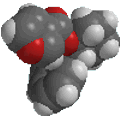 |
Chapter 17: Aldehydes
and Ketones. Nucleophilic Addition to C=O |
 |
Spectroscopic Analysis
of Aldehydes
|
Absorbance (cm-1)
|
Interpretation
|
|
1710 -1750
|
C=O stretch
|
|
~2720
|
C-H stretch of aldehydes
|
|
~2820
|
C-H stretch of aldehydes
|
- 1H
NMR - the CH=O unit of aldehydes is the most easily recognised.
|
Resonance (ppm)
|
Interpretation
|
|
9.0 -10.0
|
CH=O (deshielding
due to O and C=C)
|
|
~2.4
|
CH2C=O
|
|
~2.0
|
CH3C=O
|
-coupling (J, Hz) between protons
in HC-CH=O is much smaller than HC-CH=C.
- 13C
NMR
C=O typically 190-220 ppm (deshielding due to O)
- minimal intensity, characteristic
of C's with no attached H's
- UV-VIS
two absorption maxima p to p*
(< 200 nm) n to p* (> 200 nm)
- p
electron from p
of C=O
- n electron from O lone
pair
- p*
antibonding C=O
- Mass Spectrometry
Molecular ion, M+, is prominent and typically an M-1 peak.
Loss of alkyl radical leads to the formation of acyl cations (acylium ions).